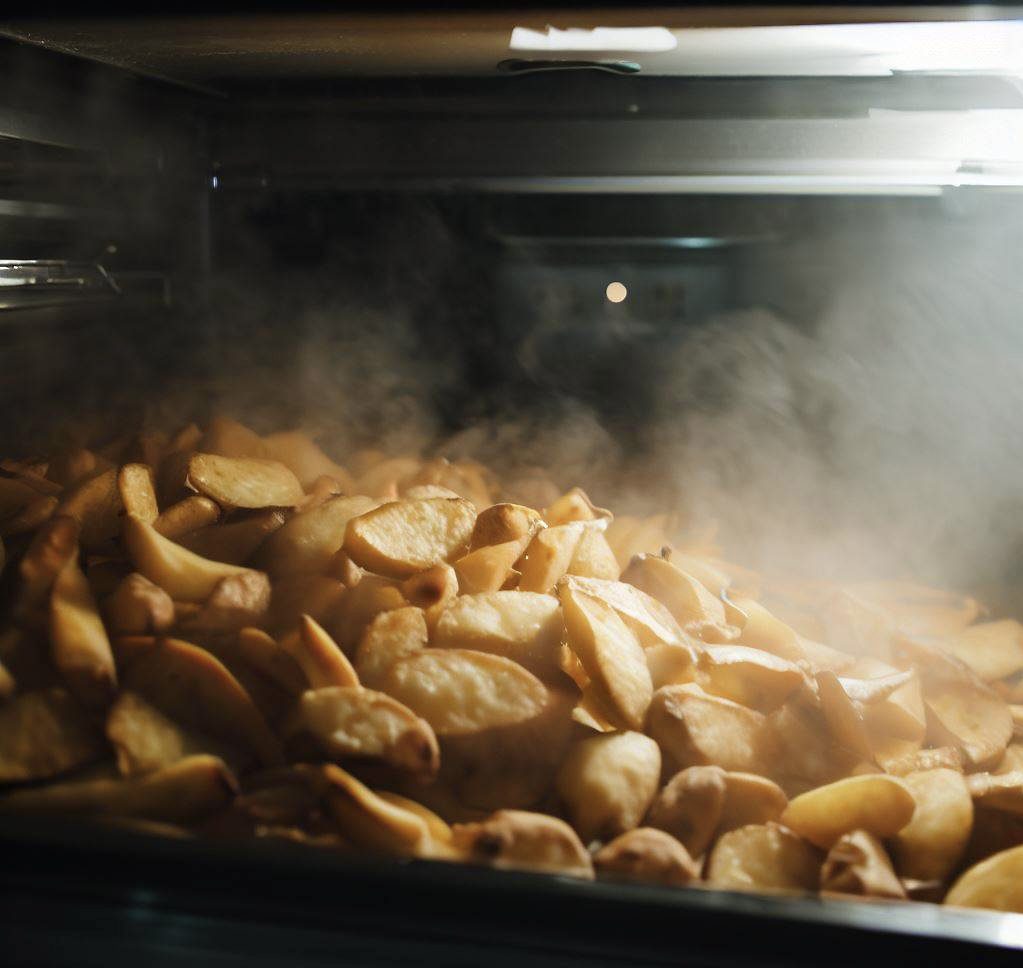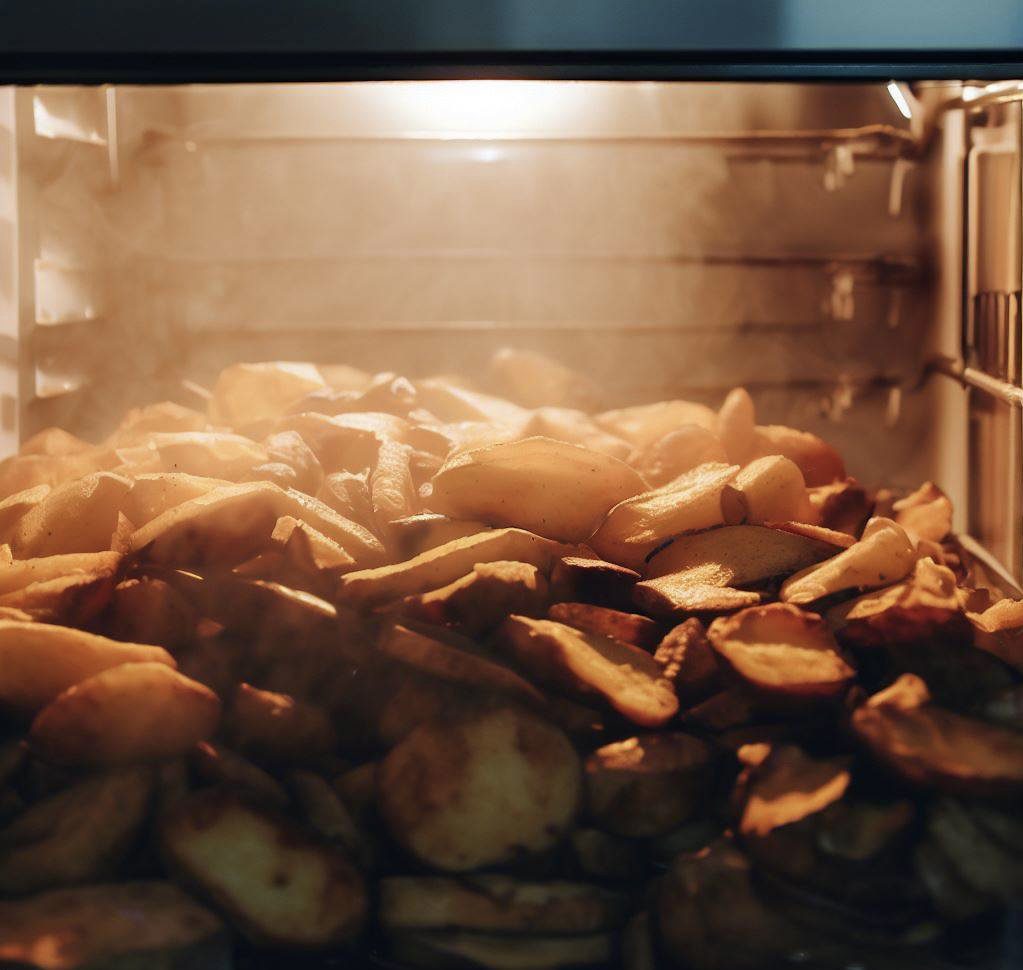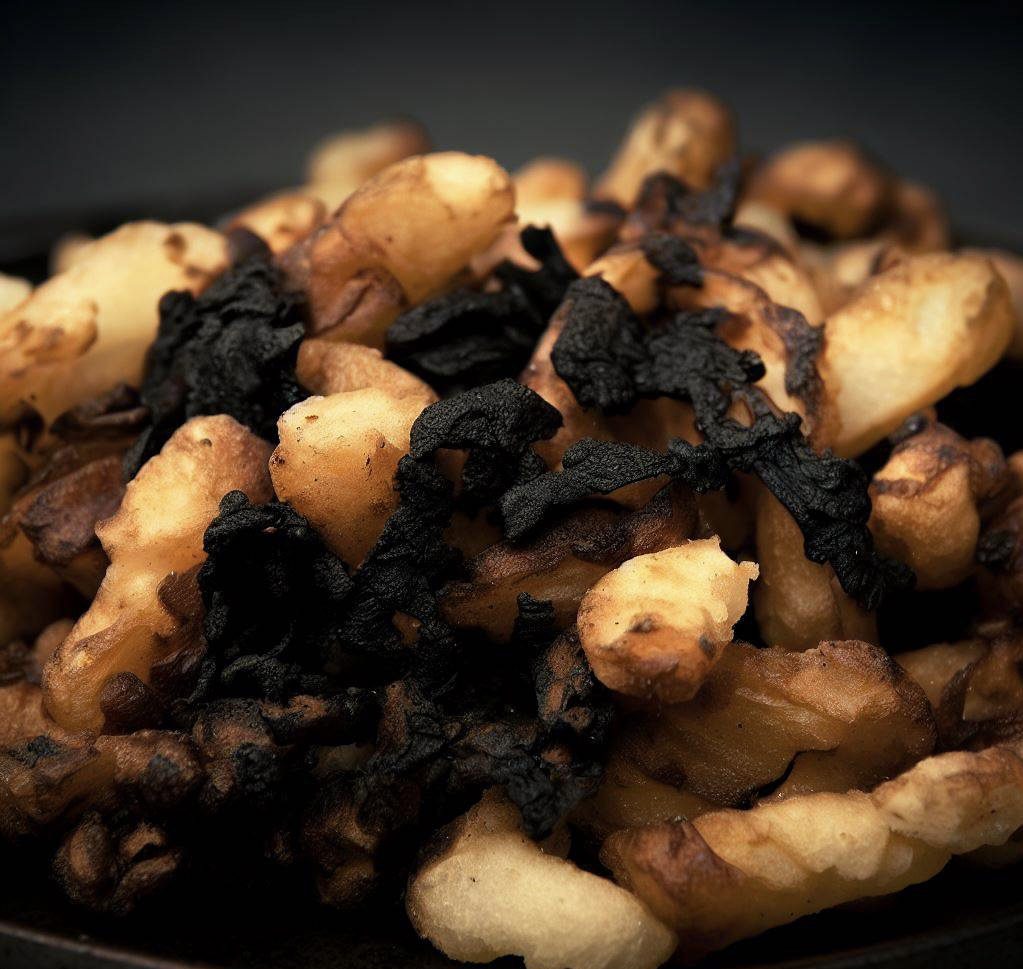Fried potatoes are a tasty and well liked accompaniment that comes in different variations like French fries or hash browns. However, if you’ve made a batch of them, you might be curious about how long they can stay good before going bad. This article will delve into the shelf life of fried potatoes and offer some advice on storing them correctly to preserve their freshness for as long as possible.

fried-potatoes-inside-fridge
Table of Contents
Understanding the Shelf Life of Fried Potatoes
When it comes to the lifespan of fried potatoes, it’s worth considering that several factors can impact how long they stay fresh. These factors include the type of potato used, the frying method and the way they are stored.
Typically, if you keep fried potatoes in the refrigerator, they can last for around 2 -3 days. It’s advisable to store them in an airtight container or wrap them tightly with aluminum foil to retain their crispiness and prevent moisture loss. However, do keep in mind that their texture might change over time, becoming less crispy and more soggy.
For extended storage, freezing is also an option for fried potatoes. By properly freezing them, you can maintain their quality for up to 2 months. To freeze them correctly, allow the potatoes to cool down completely before placing them in a freezer safe container or plastic bag. Remember to remove as much air as possible to avoid freezer burn.
Also check out: Can I eat chicken soup that has been left out overnight?
It’s important to mention that the taste and texture of frozen and reheated fried potatoes may not be as good as fresh ones. Freezing can cause them to become slightly mushy, but they can still be enjoyed for a quick and convenient side dish.
To keep track of the freshness of your fried potatoes, it’s a good idea to label them with the date of preparation before storing them. This way, you can easily determine how long they have been in the refrigerator or freezer.
The shelf life of fried potatoes can range from a few days when refrigerated to a few months when frozen. By properly storing them in airtight containers or freezer-safe bags, you can prolong their freshness and enjoy them as a tasty side dish for longer. Remember to always check for any signs of spoilage, such as a foul odor or mold, before consuming fried potatoes.
Factors Affecting the Shelf Life

fried-potatoes-inside-fridge-2
When it comes to fried potatoes, their shelf life can be influenced by several factors. One important factor is the way they are stored after cooking. It should be stored properly to maintain their quality and extend their shelf life. The following are some key factors that can affect the shelf life:
- Temperature: Storing fried at room temperature can significantly reduce their shelf life. It is important to refrigerate them as soon as they have completely cooled down to prevent bacterial growth and maintain their freshness.
- Moisture: Excess moisture can make fried potatoes soggy and increase the risk of bacterial growth. It is crucial to drain excess oil thoroughly before storing them. Using a paper towel to absorb any remaining oil can help prolong their shelf life.
- Packaging: Proper packaging is essential for preserving the quality. Storing them in an airtight container or wrapped tightly in aluminum foil can help prevent moisture loss and avoid exposure to air, which can lead to faster spoilage.
- Quality of Potatoes: The freshness and quality of the potatoes used can also impact their shelf life. Using fresh potatoes that are free from any signs of spoilage or damage can result in longer-lasting.
The Impact of Storage Conditions on Fried Potatoes
The storage conditions of fried potatoes can significantly affect their shelf life and overall quality. Here are a few key considerations:
- Refrigeration: Storing fried potatoes in the refrigerator can help prolong their shelf life. They can generally last for around 3 to 5 days when refrigerated properly. It is important to use an airtight container or wrap them tightly in foil to prevent moisture loss and maintain their crispness.
- Freezing: It can also be frozen to extend their shelf life further. It is recommended to freeze them in airtight containers or freezer bags to prevent freezer burn. When properly stored, frozen fried potatoes can last for up to 3 months.
- Reheating: When reheating, it is crucial to ensure they reach a temperature of at least 165°F (74°C) to kill any potential bacteria. Reheating thoroughly can help maintain their quality and reduce the risk of foodborne illnesses.
Remember, these are general guidelines, and the shelf life of fried potatoes might slightly vary depending on the specific recipe and storage conditions. It is important to use your judgment and consider the overall appearance, texture, and smell of the fried potatoes before consuming them.
By following proper storage practices and considering these factors, you can enjoy fried potatoes for a longer period while maintaining their quality and taste.
How Long Do Fried Potatoes Last?
Their shelf life can vary depending on how they are stored and handled. Proper storage is key to keeping fried potatoes fresh and safe to eat for as long as possible. Here are some guidelines to keep in mind:
- Cooling and refrigeration: After frying the potatoes, allow them to cool completely before storing them. Once cooled, transfer them to an airtight container or resealable bag and refrigerate. Fried potatoes can last for about 3 to 5 days when stored properly in the refrigerator.
- Avoid moisture: Moisture can quickly make fried potatoes lose their texture and become soggy. Make sure the fried potatoes are fully cooled and dry before storing them. Avoid storing them in a container with condensation or moisture build-up.
- Avoid excessive oil: Drain excess oil from the fried potatoes before storing them. Excessive oil can make the potatoes greasy and spoil faster. Blot the fried potatoes with a paper towel to remove any excess oil.
- Container choice: Choose an airtight container or resealable bag to store. This helps to prevent air and moisture from entering, which can lead to spoilage. Ensure the container or bag is properly sealed to maintain freshness.
- Proper temperature: Keep the fried potatoes refrigerated at a temperature below 40°F (4°C). This helps to inhibit the growth of bacteria and extend their shelf life. Always use a refrigerator thermometer to ensure the temperature is accurate.
- Reheating: When reheating, it’s best to do so in the oven or toaster oven to help retain their crispiness. Avoid reheating in the microwave, as it can make them soft and less appetizing.
It’s important to note that the quality and taste of fried potatoes may deteriorate over time. The longer they are stored, the more they may lose their crispness and flavor. It’s best to consume them within the recommended timeframes for the best experience.
Summary:
Properly stored, fried potatoes can last for about 3 to 5 days in the refrigerator. Remember to cool them completely, blot any excess oil, store in an airtight container, and maintain a temperature below 40°F (4°C). Reheating in the oven helps retain their crispiness. Enjoy them while they’re still fresh and delicious!
Continue reading to learn more about storing and preserving different types of food.
Reference and read more: https://www.allrecipes.com/article/how-long-do-potatoes-last/
https://www.webmd.com/food-recipes/how-to-keep-potatoes-fresh-for-longer
Signs of Spoilage

spoiled-fried-potatoes
Like any food, fried potatoes can go bad over time, and it’s important to be able to identify the signs of spoilage. Here are some common indicators that fried potatoes have gone bad:
- Change in color and texture: If they have turned dark brown or black, or if they are soft and mushy instead of crispy, it’s a clear sign that they are no longer good to eat.
- Unpleasant smell: Bad fried potatoes may have a foul or sour odor. If you notice any strange or off-putting smells, it’s best to discard them.
- Mold or signs of growth: If you see any green or fuzzy spots, it’s a sure sign of mold or bacterial growth. In this case, it’s important to throw them away, as mold can be harmful to your health.
- Sliminess: If it feel slimy or have a greasy texture, it’s a sign that they have started to spoil. This can be due to bacterial growth or improper storage.
How to Identify if Fried Potatoes have Gone Bad
To determine if fried potatoes have gone bad, here are some simple steps to follow:
- Examine the appearance: Check for any noticeable changes in color, texture, or the presence of mold or growth. Discard any that show signs of spoilage.
- Smell: Take a whiff of the fried potatoes. If they have an unpleasant or off odor, it’s a clear sign that they are no longer fresh and should be discarded.
- Touch: Feel the texture. If they are soft, mushy, or slimy to the touch, it’s a sign of spoilage.
It’s important to mention that proper storage plays a significant role in extending the shelf life.
Tips for Maximizing the Freshness of Fried Potatoes:
- Allow the potatoes to cool: Before storing, make sure to let them cool completely. This helps prevent condensation and moisture buildup, which can lead to sogginess.
- Use an airtight container: Transfer the cooled fried potatoes into an airtight container or a resealable plastic bag. This helps minimize contact with air, which can cause them to spoil faster.
- Store in the refrigerator: It can be stored in the refrigerator to extend their shelf life. Keep them in the main compartment of the refrigerator, away from raw meats and other strong-smelling foods.
- Label and date: To keep track of the storage time, label the container or bag with the date you stored them. This will help you know when they should be consumed.
- Reheat properly: When reheating, it’s best to use an oven or toaster oven instead of the microwave. This helps maintain their crispy texture.
Safety Precautions
It’s important to be mindful of safety precautions to ensure a healthy and safe dining experience. Here are some key tips to keep in mind:
- Proper storage: it’s essential to store them properly to maintain their quality and reduce the risk of foodborne illnesses. Place them in airtight containers and store them in the refrigerator within two hours of cooking.
- Time limit: Fried potatoes should ideally be consumed within four days of cooking. Beyond that, the risk of bacterial growth increases significantly.
- Reheating: If you have leftovers, it’s important to reheat them thoroughly before eating. Heating to a temperature of at least 165°F (74°C) can help kill any bacteria that may have multiplied during storage.
- Avoid cross-contamination: it’s crucial to prevent cross-contamination with other foods. Use separate utensils and cutting boards for raw and cooked foods to minimize the risk of spreading harmful bacteria.
Here’s a table summarizing the safety precautions for fried potatoes:
| Safety Precautions |
|---|
| Proper storage |
| Time limit |
| Reheating |
| Avoid cross-contamination |
Sources:
- Food Safety News: Important Food Safety Tips for Cooked Potatoes
- Gordon Food Service: Smart Starch – Potato Food Safety
Creative Uses for Leftover Fried Potatoes
Leftover can be a delicious addition to your meals even after they’ve been cooked. With a little creativity, you can repurpose them into different dishes and enjoy their unique flavors in new ways. Here are some ideas for repurposing leftover fried potatoes:
Ideas for Repurposing Leftover Fried Potatoes
- Breakfast Burrito: Wrap your leftover fried potatoes in a tortilla with scrambled eggs, cheese, and your favorite breakfast ingredients for a hearty and satisfying morning meal.
- Potato Hash: Chop up the fried potatoes and sauté them with onions, bell peppers, and any other vegetables you like. Add some cooked bacon or sausage for an extra burst of flavor.
- Loaded Nachos: Transform into a tasty nacho dish by layering them with cheese, salsa, guacamole, and sour cream. Bake until the cheese is melted and serve as a delicious snack or appetizer.
- Potato Salad: Dice and use them as a base for a flavorful potato salad. Mix them with mayo, mustard, chopped pickles, and herbs for a tasty side dish.
- Shepherd’s Pie: Layer your leftover with cooked ground meat, vegetables, and gravy, then bake until golden and bubbly. This classic dish is a great way to use up leftover potatoes and create a comforting dinner.
- Skillet Frittata: Incorporate into a savory frittata by mixing them with beaten eggs, cheese, and your choice of vegetables. Cook in a skillet until set and enjoy a hearty brunch or lunch option.
- Potato Soup: Add your leftover to a pot of soup for added texture and flavor. They can enhance creamy potato soups or chunky vegetable soups, giving them a delightful twist.
By repurposing your leftover fried potatoes, you can minimize food waste and create exciting dishes that are both delicious and satisfying. Get creative and experiment with different flavors and combinations to make the most out of your leftovers.
FAQ (Frequently Asked Questions)
Answers to Common Queries about Fried Potatoes
When it comes to fried potatoes, there are often questions about their shelf life and how long they can be safely consumed. Here are some frequently asked questions and their answers:
Q: How long do fried potatoes last?
A: Fried potatoes can last for about 2-3 days when stored properly in the refrigerator. It is important to keep them in an airtight container to maintain their freshness.
Q: Can I reheat fried potatoes?
A: Yes, you can reheat fried potatoes. To ensure they are safe to eat, it is recommended to reheat them to an internal temperature of 165°F (74°C) to kill any bacteria that may have formed.
Q: What is the best way to store fried potatoes?
A: To store, place them in an airtight container and store them in the refrigerator. This helps to maintain their texture and flavor for a longer period.
Q: Can I freeze fried potatoes?
A: Yes, you can freeze fried potatoes. However, it is important to note that freezing may affect their texture and crispiness. To freeze, place them in a freezer-safe container or bag and label them with the date. They can be stored in the freezer for up to 2 months.
Q: What are the signs that fried potatoes have gone bad?A: If it have an unpleasant odor, mold, or if they appear discolored or slimy, it is best to discard them. Consuming spoiled fried potatoes can lead to food poisoning.
It is crucial to follow proper storage and reheating guidelines to ensure the safety and quality. Always use your best judgment and trust your senses when determining whether fried potatoes are still suitable for consumption.
For more information on potatoes and recipes, you can visit the Idaho Potato Commission’s website for frequently asked questions about fried potatoes.
Conclusion
Fried potatoes have a shorter shelf life compared to raw or cooked potatoes due to the added oil and cooking process. Here are some key takeaways and final thoughts on fried potatoes’ shelf life:
Key Takeaways and Final Thoughts on Fried Potatoes’ Shelf Life
- Fried potatoes, whether homemade or store-bought, typically last for about 2-3 days in the refrigerator.
- To maximize the shelf life of fried potatoes, it’s crucial to store them in an airtight container to prevent moisture and odors from affecting their quality.
- Fried potatoes should be stored in the refrigerator at a temperature of 40°F (4°C) or below.
- It is not recommended to freeze fried potatoes, as the texture and taste may significantly change after thawing.
- When reheating fried potatoes, make sure to heat them thoroughly to an internal temperature of 165°F (74°C) to eliminate any potential bacteria growth.
- It’s important to note that consuming spoiled or moldy fried potatoes can lead to foodborne illnesses, such as food poisoning.
- Always check for signs of spoilage, such as an off smell, unusual texture, or the presence of mold. If any of these signs are observed, it is best to discard the fried potatoes.
- Proper hygiene, including washing hands and utensils, is crucial when handling and preparing fried potatoes to avoid cross-contamination.